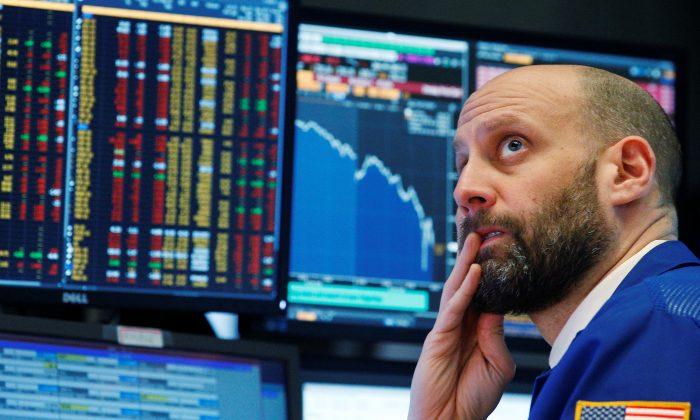It had been a long time coming.
The speed of Monday’s jaw-dropping sell-off on Wall Street had traders and investors bumped and bruised. But few seemed surprised that a pullback had actually happened. Some were looking for the right time and opportunity to wade back in—but wary of catching a falling knife.
“We finally got the correction we were all kind of figuring would happen,” said Paul Nolte, portfolio manager at Kingsview Asset Management in Chicago. “It feels a lot more painful only because we haven’t seen it in 14-15 months or so, and it’s certainly, from the way we look at it, healthy.”
Stocks have been on a bull run since 2009, accelerated in the last year by strong earnings and the Trump administration’s corporate tax cut. The S&P 500 rose 19 percent in 2017 alone.
But with valuations sky high after the buying binge carried deep into January, something had to give. The down days started last week. The shakeout accelerated on Friday, with the S&P’s biggest drop since September 2016 after jobs data raised the specter of inflation and spooked investors.
Monday started out in the red, but calm. The afternoon was anything but, as frantic selling set in.
Catch a Falling Knife?
The Dow briefly entered correction territory on Monday with a 10 percent dip from its Jan. 26 record. It ended down 4.6 percent on the day, while the S&P 500 fell 4 percent.Since the S&P’s Jan. 26 all-time high it has fallen 7.8 percent. Of its 11 sectors, energy led the decline with a 10.5 percent drop followed by a 9.4 percent drop in healthcare and an 8.8 percent drop in materials. The best performer was utilities with a decline of just under 4 percent (3.97) followed by real estate which fell 5.1 percent and telecom, which fell 5.5 percent.
After the close of trading, equity futures traded sharply down, indicating another day of selling was ahead.
“If I were running a hedge fund, I wouldn’t be rushing to buy; I'd be waiting,” said Michael Purves, chief global strategist at Weeden & Co in New York.
No S&P sector looked like a safe bet in the current environment.
“I have a strong feeling that this sell-off is going to intensify because bears are seeing blood on the Street and all they want is right in front of them,” Naeem Aslam, chief market analyst at ThinkMarkets, London
Even so, some investors went shopping as they kept their focus on strong economic data and earnings growth.
The utilities and real estate indexes performed better than the S&P on Monday, but with declines of 1.7 percent and 2.7 percent, the traditionally defensive sectors could hardly be called safe havens.
These are considered bond proxies, and along with consumer staples and telecommunications, are seen as relatively safe in even the dourest markets due to their high dividend yields and predictable if slow growing earnings.
But with interest rates rising, the dividend yields look less competitive compared with bond yields.
Looking for the Safest Bet
“Right now there’s no safe place to hide,” said Robert Pavlik, chief investment strategist and senior portfolio manager at SlateStone Wealth LLC in New York.However Pavlik said he bought stocks on Friday, and on Monday as he was banking on a continuation of strong economic growth and a rapid increase in U.S. earnings.
“This is not going to be a protracted sell-off. This is going to happen relatively quick because the economic numbers are still so good,” he said.
Since the S&P’s financial sector fell 5 percent on Monday, some investors said they saw the decline as a buying opportunity as bank profits are boosted by rising interest rates because they can charge customers more for borrowing money.
“You have a great opportunity to buy financials here,” said Phil Blancato, CEO of Ladenburg Thalmann Asset Management in New York. “With a strengthening consumer that’s going to continue to borrow and spend your best opportunity is in financials and technology.”
In particular Apple Inc, which fell 6.7 percent in the last two sessions, looked like a bargain to Blancato, who said he bought the stock Monday. “Apple is getting very inexpensive.”
While the broader market is punished by inflation anxiety, Jim Paulsen, chief investment strategist at the Leuthold Group in Minneapolis says investors should buy stocks in energy and materials companies and in a diverse array of commodities to profit from rising commodity prices.
“If commodities rise maybe stocks go down over all. Even energy and materials stocks might come down but they might outperform,” said Paulsen.






Friends Read Free